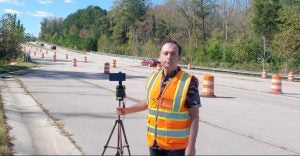ECU professor developing safety device for road workers
Earlier this month, a road construction worker in Ohio was struck and killed by a car. Last year near Statesville, three road workers were killed when they were struck while fixing a guard rail on Interstate 40.

Dr. Erol Ozan
Dr. Erol Ozan, associate professor in the Department of Technology Systems at East Carolina University, is working on a device that may help prevent deaths and serious injuries when vehicles intrude on road construction sites.
“This is a problem recognized by the industry,” Ozan said. “An intrusion where a vehicle hits a worker is still kind of a rare event, but when you look at the occupational safety statistics, it’s high compared to other occupations and it makes being a road construction worker one of the riskiest occupations in the U.S.”
According to the National Work Zone Information Clearinghouse, which collects federal data on crashes in work zones, 1,249 workers died in work zone crashes from 2010 to 2019. Although statistics were not yet available for 2020, The Associated Press reported that some states saw increases in road construction crashes despite a decrease in the number of drivers on the road because of the coronavirus pandemic. Officials cited speeding and distracted driving as reasons behind the increases.
Ozan developed a device through a $38,537 grant from the N.C. Department of Transportation that is designed to detect vehicles that intrude on road construction sites and warn workers of the potential danger. Though that grant ended in July of last year, Ozan kept working and made a number of improvements, including updated software and interface modules, and a remote pan/tilt motor to control the angle of the sensor. The modified device was tested in the field in the fall of 2020 and produced positive results.
Now with a prototype ready, Ozan has received a second grant from the NCDOT for $12,402 for pilot testing, which is expected to start in late August at a still to be determined work site.
“When a motorized vehicle enters into a restricted area, typically the area covered by traffic cones, it generates an alarm sound and generates an alarm sound on the personal devices of the workers, and those devices also vibrate,” Ozan said. “That way we warn workers that there’s a vehicle approaching them so that they can escape to safety and not get hit by the vehicle.”

Dr. Erol Ozan, associate professor in the Department of Technology Systems at East Carolina University, is working on a vehicle intrusion system that may help prevent deaths and serious injuries of workers at road construction sites. (Contributed photo)
Ozan said the prototype uses a mix of artificial intelligence technology, camera-based detection and a device with which most people are familiar.
“I’m using smart phones as hardware,” he said. “I’m taking advantage of the smart phones’ various sensors and pretty good processing power, so hopefully this will be a cost-effective solution that is widely available, which I think is another strength.”
He said though there are some vehicle intrusion warning products on the market, they have not met with complete satisfaction in the road construction industry.
“Customers and potential customers are not really happy with those products meeting their requirements, and I think the technology I have addresses some of the shortcomings of the existing technology,” he said. “I’m using a different approach from what’s in the marketplace right now.”
Various data collection and scientific observation methods will be used during prototype testing, which will take place in at least two construction sites selected by NCDOT. Observations by workers and a survey to gauge user friendliness, ease of setup, performance and compatibility with the work zone environment will also be used to evaluate the effectiveness of the prototype.
“If this device can save only one life or save a serious injury, it’s worth it. It’s a great achievement,” Ozan said.